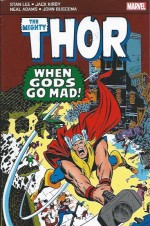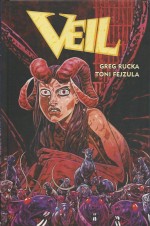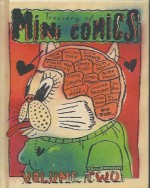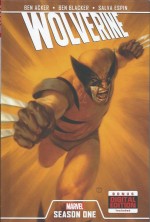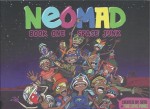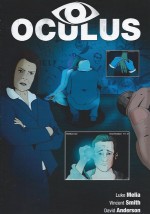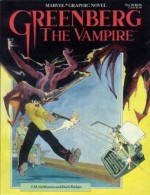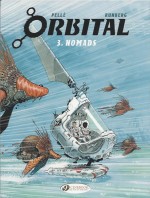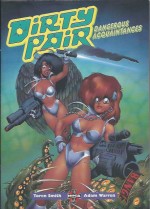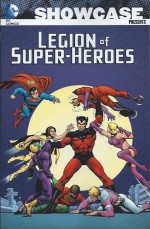
By Cary Bates, Jim Shooter, Paul Levitz, Dave Cockrum, Mike Grell & various (DC Comics)
ISBN: 978-1-4012-4297-8
Once upon a time, a thousand years from now, a band of super-powered kids from a multitude of worlds took inspiration from the greatest legend of all time and formed a club of heroes. One day those Children of Tomorrow came back in time and invited their inspiration to join them…
Thus began the vast and epic saga of the Legion of Super-Heroes, as first envisioned by writer Otto Binder & artist Al Plastino when the many-handed mob of juvenile universe-savers debuted in Adventure Comics #247 (April 1958), just as the revived superhero genre was gathering an inexorable head of steam in America.
Since that time the fortunes and popularity of the Legion have perpetually waxed and waned, with their future history tweaked and overwritten, retconned and rebooted over and over again to comply with editorial diktat and popular fashion.
This sturdy, cosmically-captivating fifth massive monochrome compendium gathers a chronological parade of futuristic delights from Superboy #193, 195, and Superboy starring the Legion of Super-Heroes #197-220, covering February 1973 to October 1976, as well as the debut issue of opportunistic spin-off Karate Kid #1 (March 1976) at a time when the superhero genre had again waned but which was slowly recovering to gain its current, seemingly unassailable ascendancy.
That plunge in costumed character popularity had seen the team lose their long-held lead spot in Adventure Comics, be relegated to a back-up in Action Comics and even vanish completely for a time. Legion fans however are the most passionate of an already fanatical breed…
No sooner had the LSH faded than agitation to revive them began. After a few tentative forays as an alternating back-up feature in Superboy, the game-changing artwork of Dave Cockrum inspired a fresh influx of fans and the back-up soon took over the book – exactly as they had done in the 1960s when the Tomorrow Teens took Adventure from Superboy and made it uniquely their own…
The resurgent dramas begin here with the back-up by Cary Bates & Cockrum from Superboy #193 wherein a select team consisting of Chameleon Boy, Duo Damsel, Chemical King and Karate Kid went undercover on a distant world to prevent atomic Armageddon in ‘War Between the Nights and the Days!’
That’s followed by #195’s ‘The One-Shot Hero!’ which told the story of ERG-1 – a human converted to sentient energy in an antimatter accident. The character had been mentioned in a 1960’s tale of the Adult Legion but here Bates & Cockrum at last fleshed out his only mission and heroic sacrifice with passion and overwhelming style…
The really big change came with the July issue as the long-lived title (it had premiered in 1949 just as the Golden Age was coming to an end) became Superboy starring the Legion of Super-Heroes with #197.
The relaunch offered a full-length extravaganza, ‘Timber Wolf: Dead Hero, Live Executioner!’ which saw the Boy of Steel summoned to the future to be greeted by a hero he believed long dead in the line of duty.
Somehow Timber Wolf has escaped the grave and triumphantly greets his old comrade, but astute Legion leader Mon-El fears some kind of trick and is proved right when the miraculous survivor goes berserk at an awards ceremony, attempting to assassinate the President of Earth.
Wolf is restrained before any harm can be done and a thorough deprogramming soon gives him a clean bill of mental health. Unfortunately that’s exactly what the team’s hidden enemy had planned and when a deeper layer of brainwashing kicks in the helpless mind-slave turns off the security systems allowing militaristic alien warlord Tyr to invade Legion HQ.
Thankfully telepathic Saturn Girl is on hand to free the mental vassal and scupper the assault, but in the scuffle Tyr’s computerised gun hand escapes, swearing vengeance…
The organisation’s greatest foes resurface with a seemingly infallible plan in #198’s ‘The Fatal Five Who Twisted Time!’ – travelling back to 1950s Smallville to plant a device which will edit the next thousand years to prevent the LSH from forming.
As second chapter ‘Prisoners of the Time Lock’ reveals, however, a squad comprising Brainiac 5, Element Lad, Karate Kid, Princess Projectra, Chameleon Boy and Mon-El has already escaped to the relative safety of the time stream, determined to restore history or die with the resultant clash concluding in a ‘Countdown to Catastrophe’…
With an entire issue to play with and short stories clearly popular, the format settled on alternating epics with a double-dose of vignettes. Thus issue #199 opened with ‘The Gun That Mastered Men!’ as Tyr’s computerised wonder weapon returned to liberate its creator, only to rebel at the last moment and try to take over Superboy’s body instead. With that threat comprehensively crushed, Bouncing Boy then took centre stage to relate his solo battle against Orion the Hunter in ‘The Impossible Target’…
It was mere prelude to the anniversary issue #200 wherein he lost his power to hyper-inflate and had to resign. However it did allow the Bounding Bravo to propose to girlfriend Duo Damsel, unaware that she had been targeted to become ‘The Legionnaire Bride of Starfinger’…
The marriage was an event tinged with grandeur and tragedy as the super-villain kidnapped her in ‘This Wife is Condemned’, attempting to emulate her powers and make an army of doppelgangers but ‘The Secret of the Starfinger Split!’ was never revealed after Superboy enacted a cunning counter-ploy…
Issue #201 featured the resurrection of ERG-1 as the energy-being reconstituted himself to save the Legion from treachery in ‘The Betrayer From Beyond’ whilst ‘The Silent Death’ saw precognitive Dream Girl infallibly predict a comrade’s imminent demise even though no hero anywhere appeared to be endangered…
Superboy starring the Legion of Super-Heroes #202 was a 100-Page Giant but only two tales were new. They were also Cockrum’s final forays in the 30th century and saw the debut of his equally impressive successor Mike Grell as inker on ‘Lost a Million Miles from Home!’
Here Colossal Boy and Shrinking Violet face a perplexing mystery in deep space: an inexplicable loss of ship’s power which compels them to abandon ship in the worst possible place imaginable…
‘Wrath of the Devil-Fish’ by Bates & Cockrum was the artist’s swan song, featuring the debut of the re-designated ERG-1 as Wildfire and an eerie amphibian creature who attacked a pollution-cleansing automated Sea-Station. Of course the monster was not what he seemed and the Legion thought they might have found a unique new recruit…
Having utterly transformed the look, feel and fortunes of the Legion, Cockrum moved to Marvel where he would perform the same service for another defunct and almost forgotten series entitled X-Men…
With Grell now handling the full art, our youthful Club of Champions were still on the meteoric rise, depicted as a dedicated, driven, grittily realistic combat force in constant, galaxy-threatening peril. However the super-science stalwarts still struggled against a global resurgence in spiritual soul-searching and supernatural dramas, with most of the comics industry churning out a myriad of monster and magic tales.
Thus the genre even invaded the bastions of graphic futurism in #203’s ‘Massacre by Remote Control’ (Bates & Grell) when increasing indifference and neglect caused veteran legionnaire Invisible Kid to lose his life saving his comrades.
The sadness was tinged with joy, however, as this was a twist on gothic ghost stories and the fallen hero was united with a lover from the other side of the Veil of Tears…
It was back to sensibly rational ground for SsLSH #204 and ‘The Legionnaire Nobody Remembered’, wherein the heroes explored the secrets of time traveller Anti-Lad whose accidental meddling altered history, demanding a most hands-on response to fix everything. Bates & Grell then exposed ‘Brainiac 5’s Secret Weakness!’ by reigniting his millennium-spanning romance with Supergirl…
Issue #205 was another mostly-reprint 100-Page Giant but included one novel-length saga which saw 20th century Lana Lang save the assembled heroes from becoming ‘The Legion of Super-Executioners’ after the entire team was overwhelmed by a psionic immortal who patiently planned to abduct them all and breed a super-army of conquest…
‘The Legionnaires who Haunted Superboy’ led in #206 and saw Superboy visited by dead friends Invisible Kid and Ferro Lad. This time however the underlying theme was nascent cloning science not eldritch unrest and the outcome was mostly upbeat, after which ‘Welcome Home Daughter… Now Die!’ highlighted Princess Projectra‘s dilemma as both modern hero with a commoner boyfriend and untouchable heir to a primitive feudal kingdom after a dutiful family visit resulted in an attack by a marauding monster…
SsLSH #207 opened with ‘The Rookie who Betrayed the Legion!’ as Science Police liaison Dvron seemingly colluded with mesmeric villain Universo whilst ‘Lightning Lad’s Day of Dread!’ saw the hero unite with his wicked brother Mekt to share a moment of personal grief.
It was but a prelude to the next issue (another 100-Page Giant) with a two pronged plan marooning Mon-El and Superboy in the 1950s whilst their comrades suffered the ‘Vengeance of the Super-Villains’ in the 30th Century. However the cunning murder-plot of Lightning Lord‘s Legion of Super-Villains was not clever enough to fool Brainiac 5 of wily LSH espionage chief Chameleon Boy…
During the 1960’s the main architect of the Legion’s transformation from semi-comedic adventure feature to gritty super-battalion was teenaged sensation Jim Shooter, whose scripts and layouts (generally finished and pencilled by the astoundingly talented Curt Swan) made the series irresistible to a generation of fans growing up with their heads in the Future and tension-drenched drama on their minds.
Now, after time away getting a college education and working in advertising, Shooter returned in Superboy starring the Legion of Super-Heroes #209 with ‘Who Can Save the Princess?’ tersely detailing how Projectra succumbing to the lethal Pain Plague led her lover Karate Kid to make an ultimate sacrifice.
Bates & Grell then wrapped up the issue with a heart-warming mystery as young fan Flynt Brojj became a ‘Hero for a Day’; saving the Legion from an insidious assassination attempt…
Issue #210 was an all Shooter/Grell affair, opening with far darker fare as ‘Soljer’s Private War’ revealed how a tragic victim of World War VI was transformed by horrific circumstances and resurrected to rampage unstoppably through 30th century Metropolis after which ‘The Lair of the Black Dragon’ revealed the incredible origin of Karate Kid.
When a pack of martial artists attack the hero, their defeat leads to a further attack on the aged Sensei who trained Val Armorr from birth, and painful revelations that the Legionnaire’s birth-father was Japan’s greatest villain…
In issue #211 ‘The Ultimate Revenge’ (Shooter) saw Element Lad risk his career and honour to exact vengeance from space pirate Roxxas who exterminated the hero’s entire race whilst Bates detailed how the Legion of Substitute Heroes took possession of ‘The Legion’s Lost Home’ incidentally solving one of the most infamous cold cases in the history of theft…
Shooter was now main writer on the series and SsLSH #212 began with ‘Last Fight for a Legionnaire’ wherein a sextet of ambitious and disgruntled teens challenged Matter-Eater Lad, Saturn Girl, Cosmic Boy, Phantom Girl, Shrinking Violet and Chameleon Boy for their positions on the team – resulting in the replacement of one of veteran heroes – whilst ‘A Death Stroke at Dawn’ found ineffectual-seeming Substitute Legionnaire Night Girl rediscovering her confidence by triumphantly saving boyfriend Cosmic Boy and herself from murderous ambushers…
In #213 Ultra Boy only realised he was afflicted with a crippling psychological handicap when the hunt for infallible super-thief Benn Pares took the team into ‘The Jaws of Fear’ after which Timber Wolf overcame a far more physical threat with his rarely exercised wits when attacked by mega-thug Black Mace in ‘Trapped to Live – Free to Die!’ by Shooter, Grell and inker Bill Draut.
In #214 the heroes found ‘No Price Too High’ to save a trillionaire’s obnoxious son from himself and the deranged, disaffected employee who had taken over one of his dad’s automated manufacturing worlds before Bates, Grell & Draut revealed the deep-seated trauma which took away Shrinking Violet’s powers in ‘Stay Small – Or Die!’
Luckily for Brainiac 5, his drastic plan to shock her back to normal worked in time for her to save him from the fallout of his own callous actions…
Bates & Grell also observed ‘The Final Eclipse of Sun Boy’ in SsLSH #215, as an intangible assassin stalked Phantom Girl to Earth and was in turn followed by an unlikely and unsuspected ally, before Shooter, Grell & Draut revealed Cosmic Boy as ‘The Hero Who Wouldn’t Fight’: honouring a sacred day of penance and super-power abstinence even at the cost of his life…
Despite the comics world being in the grip of martial arts madness since 1973, DC were a little slow in making an obvious move and giving one of the oldest comicbook Kung Fu fighters his own solo title.
Karate Kid #1 launched with a March-April 1976 cover-date and plunged valiant Val Armorr back a thousand years to contemporary New York City in ‘My World Begins in Yesterday’ by Paul Levitz, Ric Estrada & Joe Staton.
The self-made warrior had crashed the time barrier to recapture arch enemy Nemesis Kid, and, after rejecting friendly advice and stern orders to return to Tomorrow, tracked and trashed his enemy with the astounded assistance of schoolteacher Iris Jacobs.
Finding the primitive milieu far more amenable than his origin era, Karate Kid unexpectedly then elected to stick around in the 20th century…
That same month SsLSH #216 saw Bates & Grell tackle a thorny issue in ‘The Hero who Hated the Legion’ as the team tried to recruit its first black member. The isolationist Tyroc and his entire long-sequestered race carried a big grudge and it took determined diplomacy and a crisis which threatened the entire island of Marzal to challenge the prejudice of centuries…
The same creative team then took a peek into ‘The Private Lives of Bouncing Boy and Duo Damsel’ revealing how even retired Legionnaires still had to fight for their lives on occasion.
Shooter & Grell monopolised issue #217 beginning with ‘The Charge of the Doomed Legionnaires’ wherein rapacious Khund warlord Field Marshal Lorca pitted his strategic genius against Brainiac 5 but underestimated the sheer guts of his despised foes, whilst ‘Future Shock for Superboy’ found the Teen of Steel beguiled by 30th century girl Laurel Kent, blithely unaware that he was interested in his own descendant…
Superboy starring the Legion of Super-Heroes #218 revealed how Tyroc’s induction into the team was shanghaied by Zoraz, ‘The Secret Villain the World Never Knew’ (Bates & Grell) although the neophyte soon turned the tables on the interloper, after which Shooter (with story inspiration from Ken Klaczac) disclosed ‘The Plunder Ploy of the Fatal Five’ in #219.
Here the terrifying Fatal Five went on an implausible spree of cosmic crimes, gathering items which could only be used for the creation of an all-conquering army, but when the Legion capably counterattacked they realised they’d jumped to woefully wrong conclusions…
This cavalcade of chronal capers concludes with #220 as inker Bob Wiacek joined Shooter & Grell for one final brace of bombastic blockbusters, beginning with ‘The Super Soldiers of the Slave-Maker’ wherein the Legion attempted to liberate conquered planet Murgador.
With most resistance coming from the terrified inhabitants, the astounded heroes learned that a huge bomb at the world’s core made them all helpless hostages to their alien overlord, forcing an application of subterfuge and misdirection to rectify the impossible situation…
Everything wraps up here with ‘Dream Girl’s Living Nightmare’ as Chameleon Boy tried to cheat fate and save a cosmic benefactor from death despite the infallible prediction of his precognitive comrade…
The Legion is unquestionably one of the most beloved and bewildering creations in funnybook history and largely responsible for the growth of the groundswell movement that became American Comics Fandom. Moreover, these scintillating and seductively addictive stories – as much as Julie Schwartz’s Justice League or Marvel’s Fantastic Four– fuelled the interest and imaginations of generations of readers and created the industry we all know today.
If you love comics and haven’t read this stuff, you are the poorer for it and need to feed your future dreams as soon as possible.
© 1973-1976, 2014 DC Comics. All Rights Reserved.
